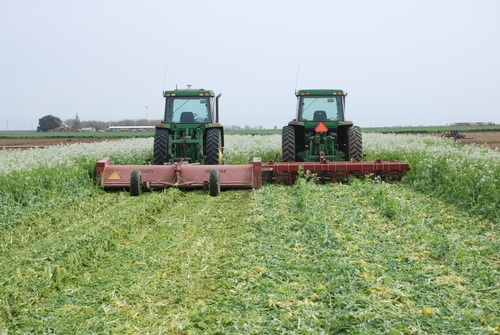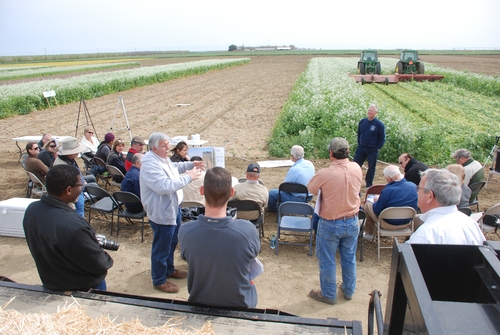Cover crops, or vegetation that was grown after the cash crop was harvested, was a practice that was widely used in the 1940s and 1950s. The vegetation was used to maintain or increase the fertility of the soil before commercial fertilizers became widely available. The cover crops also provided organic matter to the soil that was necessary to keep the soil easy to plow. When commercial fertilizers became more widely used, cover crops faded from the agricultural picture.
Cover crops are making a comeback of sorts due to the depletion of the organic matter over the intervening decades of intense farming as well as farmers taking advantage of a cover crop’s environmental benefits. A winter cover crop can add back to the soil the organic matter that was lost due to farming practices as well as take up the fertilizer left over from the previous crop that can potentially leach into the ground water or runoff in storm water. A well-managed cover crop can also provide needed protection from raindrop impact that can cause a crust to form on the surface of the soil that further reduces water penetration and adequate air movement through the soil. The vegetation can also keep soil moisture from evaporating when young crops need it most.
To help farmers learn more about the “lost art of cover cropping” and to see actual cover crop management techniques up close and personal, the University of California’s Conservation Tillage and Cropping Systems Workgroup conducted an interactive field day on March 18 at the West Side Research and Extension Center in Five Points, Calif. The session came on the heels of a three-day conference series the previous week that provided examples of successful high-residue cropping systems that also use cover crops from other irrigated regions of the U.S.
The backdrop for the field day was a field that has been comparing no-till cotton and tomato production techniques for the last eight years. Comparisons between crops grown with and without winter cover crops have been measured against current standard “clean cultivation” management in which no cover crop is used. Also compared was a standard tillage system in which winter cover crops are “green manured” or incorporated into the soil in the spring before the next crop is planted.
UC Davis researcher, Jeff Mitchell, reported that about two tons of cover crop dry matter - of which roughly 40 percent is carbon and 2 percent is nitrogen - has been produced in the cover crop plots each year with winter rainfall and no supplemental irrigation. These cover crops resulted in a 22 percent increase in soil carbon in the green manured, standard tillage system, and an even higher 29 percent increase in soil C in the no-till cover crop system following the eight years of study.
From year to year, the water available for agriculture can vary greatly so cover crops must be able to “work their magic” with little or no increased water requirements. Because wintertime temperatures are lower and the humidity is generally higher, evapotranspiration (ET) - or the water that both evaporates from the soil and water that is used by plants - during the winter growing period tends to be much lower than in summer. However, a winter-growing cover crop is using water that would normally be available to a spring-planted crop. Therefore, farmers need to weigh the many advantages of a cover crop with the potential disadvantage of its winter water use.
Mitchell’s monitoring of the top foot of soil three days before the field day indicated about 3 inches of water in the fallow plots with only about 2.5 inches in the cover crop plots. The cover crop that Mitchell used this year consisted of Tillage Radish™, forage pea, and Phacelia, and had produced about 7,000 pounds of dry matter per acre at the time of the field day.
The field day also featured Greg Wittenborn of Lockwood Seed and Grain of Chowchilla, Calif., and Chuck Cambra and Tom Johnson of Kamprath Seed in Manteca, Calif. The trio provided information on cover crop seed costs, the importance of selecting cover crop materials, and designing cover crop strategies to achieve specific cropping goals. Many cover crop species and mixes are now commercially available to address a farmer’s specific needs.
Additional information on cover crops will be posted at the Workgroup’s website http://ucanr.org/sites/ct/ and opportunities for viewing other field operations related to cover cropping will be publicized via the Workgroup’s email announcement service. To become involved with the Conservation Tillage and Cropping Systems Workgroup, contact workgroup chair Jeff Mitchell at mitchell@uckac.edu.

Two of the methods for terminating cover crops that were demonstrated at the cover crop field day in Five Points, Calif. On the left is a conventional flail mower that flail chops standing cover crop materials leaving very small pieces of shredded above-ground material. On the right is a cover crop stalk chopper that is ground-driven and chops standing cover crops leaving 7- to 8-inch pieces of above-ground matter. (Photo by Ron Harben.)

Chuck Cambra of Kamprath Seed Company in Manteca, Calif., (in gray sweatshirt at center-left of photo) addressing participants of the cover crop field day held in Five Points, Calif., on March 18. (Photo by Ron Harben.)